Understanding Different Contract Options
This is the process of obtaining supplier responses, selecting a supplier, and awarding a contract. It may need to occur multiple times if there are multiple contracts and for each instance it will includes issuing the bid package to potential supplier, evaluating potential supplier proposals and finally selecting the winning supplier proposal.
For major procurement items, a short list of qualified supplier can be established based on a preliminary proposal before a more detailed evaluation is conducted based on a more specific and comprehensive requirements document requested from the supplier on the short list.
There are several different types of contract that can be used, although the most common is the fixed-price type, which involves setting a fixed total price for a precisely defined product or service to be provided. Changes in scope can be accommodated, but generally at an increase in the contract price. Sellers under fixed-price contracts are legally obligated to complete such contracts, with possible financial damages if they do not.
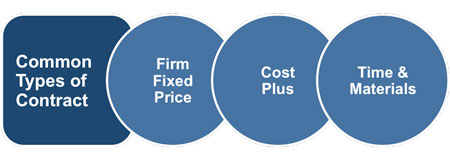 |
This type of contract has three variants:
1) Firm Fixed Price (FFP)
2) Cost Reimbursable or Cost Plus
3) Time & Material Contracts (T&M)
The FFP is the most commonly used contract type and the three most popular variants of this type of contract are: Firm Fixed Price (FFP), Fixed Price Incentive Fee (FPIF), and Fixed Price with Economic Price Adjustment (FP-EPA).
Firm Fixed Price (FFP)
Fixed price is favored by most organizations because the price is set and is not subject to change unless the scope of work changes. Any cost increases due to adverse performance would be the responsibility of the supplier .
Fixed Price Incentive Fee (FPIF)
A FPIF contract gives the customer and supplier some flexibility in that it allows for deviation from performance, with a financial incentive for achieving certain metrics. Generally the incentives are related to cost, schedule, or the technical performance of the supplier. A price ceiling is set and any costs above that ceiling are the responsibility of the supplier.
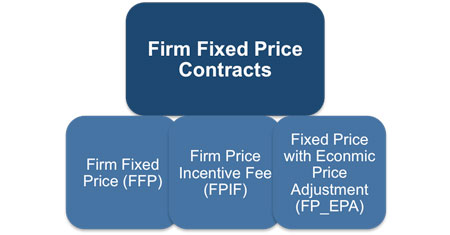 |
Fixed Price with Economic Price Adjustment (FP-EPA)
FP-EPA contracts are used for long-term contracts and they allow for pre-defined adjustments to the contract price due to changed conditions. This could include inflation changes or increased or decreased costs for specific commodities.
The contract is intended to protect both the customer and supplier from external conditions over which they have no control. This is often used where interest rates or exchange rates may affect the project, and this contract types will describe such economic adjustments based on some form of indices such as interest or currency exchange rates.
Although the firm-fixed-price type of contractual arrangement is typically the preferred type that is encouraged and often demanded by most organizations, there are times when another contract form may be in the best interests of the project. If a contract type other than fixed-price is intended, it is incumbent on the project team to justify its use. The type of contract to be used and the specific contract terms and conditions fix the degree of risk being assumed by the customer and supplier.
Cost Reimbursable or Cost Plus
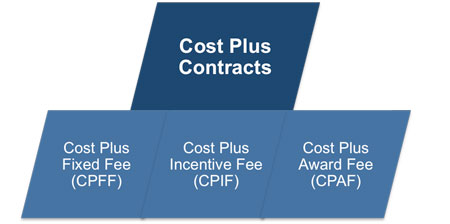 |
This type of contract involves payment to the supplier for supplier's actual costs, plus a fee typically representing seller profit. Cost-reimbursable contracts place more risk on the customer. As part of the contract negotiations the supplier is able to be reimbursed for costs that have been incurred by them that have been defined as 'reasonable' in such a contract. These costs must be incurred as a result of performing the agreed contract. Typically a 'ceiling' is set that cannot be exceeded by the supplier. This type of contract is favored in situations where costs estimates are vague due to uncertainties relating to the performance of the contract, for example aircraft development. Three common types:
Cost Plus Fixed Fee (CPFF)
In a CPFF contract the supplier is reimbursed for allowable costs for performing the work and also receives a fixed fee payment that is calculated as a percentage of the initial estimated project costs.
 |
The fee amount would only change if there were a change to the project scope.
Cost Plus Incentive Fee (CPIF)
In a CPIF contract the supplier is reimbursed for allowable costs and the supplier receives an incentive fee based on achieving certain performance objectives.
 |
If the final costs differ from the original estimated costs, then both the customer and supplier share costs based upon a pre-negotiated formula (such as 60/40). Generally the first number in the split refers to the customer's portion, the second number to the supplier's portion.
Cost Plus Award Fee (CPAF)
In a CPAF contract the seller is reimbursed for allowable costs. The majority of the fee is only earned based on the satisfaction of identified broad subjective performance criteria.
 |
The performance criteria is defined and included in the contract and the fee determination is based solely on the determination of seller performance by the customer and is usually not subject to appeals.
Time and Material Contracts (T&M)
Time and material contracts are a hybrid type of contractual arrangement that contain aspects of both cost-reimbursable and fixed-price contracts. They are often used for staff augmentation, acquisition of experts, and any outside support when a precise statement of work cannot be quickly prescribed.
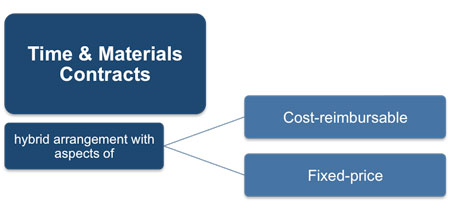 |
These types of contracts resemble cost-reimbursable contracts in that they can be left open ended and may be subject to a cost increase for the customer. The customer may not define the full value of the agreement and the exact quantity of items to be delivered at the time of the contract award.
Thus, T&M contracts can increase in contract value as if they were cost-reimbursable contracts. Many organizations require not-to-exceed values and time limits placed in all T&M contracts to prevent unlimited cost growth.
Conversely, T&M contracts can also resemble fixed unit price arrangements when certain parameters are specified in the contract. Unit labor or material rates can be preset by the customer and supplier, including supplier profit, when both parties agree on the values for specific resource categories, such as senior engineers at specified rates per hour, or categories of materials at specified rates per unit.
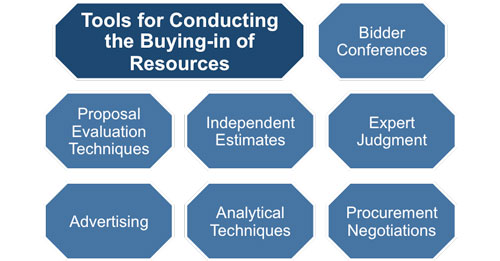 |
Where public money is being used, for example on government or local authority projects, it is vital that no bidders receive preferential treatment. A bidder conference provides equal information to all potential suppliers including answers to questions posed by one bidder that are then shared with all of the others. These can be known by various other names, and are held by a customer for all of the suppliers to whom the customer has sent a request for proposal (RFP) or a request for bid (RFB). These conferences, which may be discretionary or mandatory, provide an opportunity for bidders to meet the project management team, receive detailed instructions and ask proposal-related questions.
On complex procurements, where source selection will be made based on supplier responses to previously defined weighted criteria, a formal evaluation review process will be defined by the customer's procurement policies. The evaluation committee will make their selection for approval by management prior to the award.
The customer may ask an independent group to prepare an estimate that is used as an objective source of information. Such estimates are often called 'should cost' estimates. These can be used as a benchmark against which to measure bids. Where there are significant differences, this can indicate that the prospective suppliers misunderstood the procurement statement of work or that it was in some way unclear what was required. Decisions can include expertise from functional disciplines such as:
• Contracting
• Legal
• Finance
• Accounting
• Engineering & Design
• Research & Development
• Sales
• Manufacturing.
The objective is to evaluate supplier proposals to make sure that the brief has been understood and that the cost and time estimates are realistic.
You may also be interested in:
Managing Project Costs | Estimating Project Costs | Calculating the Total Project Budget | Monitoring Project Expenditure | Buying-in Goods and Services | Managing Project Suppliers | Planning Contract Management | Understanding Different Contract Options | Managing Supplier Relationships.
|
|


